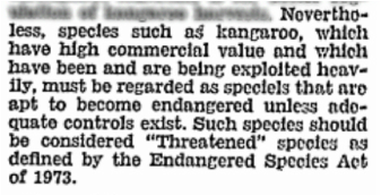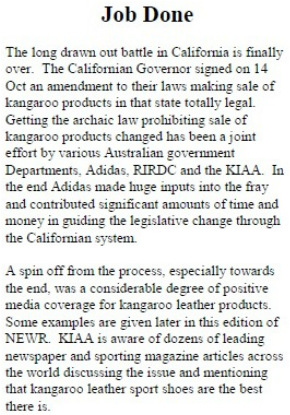California’s legislative ban on the importation of kangaroo products was due to resume its effect at the end of 2015. However the commercial kangaroo industry was confident it would convince legislators to permanently lift the ban and allow unimpeded and unchecked importation of kangaroo skins and meat.
Nearly 80 scientists, academics and researchers wrote to Californian legislators with their concerns about the shooting of kangaroos, with that letter hosted on this site (read the letter here).
On 11 September, the last day for debate on urgent bills, the industry’s bill to permanently lift the ban failed to pass the Californian Senate, allowing the ban to be reinstated from 1 January 2016.
There is increasing concern about the science that is being cited to justify the continuation of the commercial kangaroo shooting and export industries.
A brief history:
Nearly 80 scientists, academics and researchers wrote to Californian legislators with their concerns about the shooting of kangaroos, with that letter hosted on this site (read the letter here).
On 11 September, the last day for debate on urgent bills, the industry’s bill to permanently lift the ban failed to pass the Californian Senate, allowing the ban to be reinstated from 1 January 2016.
There is increasing concern about the science that is being cited to justify the continuation of the commercial kangaroo shooting and export industries.
A brief history:
|
- In 1974 the (then) three commercially shot kangaroo species were listed as threatened on the US Endangered Species Act.[2] The US Fish and Wildlife Service banned the importation of those species in the same year.
- The Australian government and kangaroo exporters then worked for three decades to remove kangaroos from the United States threatened species list, and convince the US government that commercially shot kangaroos were abundant and management practises sustainable.
- The US federal ban was lifted in 1995 and trade resumed, while the still-existing Californian and New York bans were ignored. In 2007 animal welfare organisation, VIVA! International Voice for Animals, sought to legally enforce the ban on the sale of kangaroo products in California. The Supreme Court of California confirmed that California could regulate kangaroo imports under an endangered species statute despite US federal law no longer listing kangaroos as endangered species. [3]
|
- Adidas, who lobbied Californian Senator Ron Calderon to sponsor the 2007 legislation lifting the Californian ban, then became one of his donors (or read here).
- The 2007 enabling legislation was enacted with a three year sunset clause, which expired in December 2010. Senator Ron Calderon then sponsored a bill representing the same coalition of economic interests allowing a second lifting of the ban in 2010 with an extended five-year sunset clause which ends at the end of 2015. [7]
- In 2013 Calderon was investigated for corruption, and in October 2016 was found guilty of receiving $US150,000 in bribes "in exchange for performing official acts as a legislator".
- The KIAA and the Australian Government had been lobbying hard since the end of 2014 for the ban to be permanently lifted in 2015. The Australian Government provided $143,000 to help pay for the hire of Californian legal firm Manatt, Phelps and Phillips to provide resources, expertise and contacts to convince the Californian government to permanently lift this ban. [8]
- The commercial kangaroo industry ignored the July 2015 deadline to introduce its bill to permanently lift the ban, and sought to “gut and amend” an existing Californian bill that had passed all the necessary legislative processes.
- In the gut and amend "maneuver" a legislator, at the last possible moment before the end of the legislative year, guts the original content of their bill that has passed all necessary transparent legislative reviews and public scrutiny. Its contents are then replaced with a completely different bill that is procedurally treated as having passed the same legislative scrutiny as the original bill. Gut and amends are disallowed by Californian legislative rules, which can be waived by the Rules Committee. The procedure is widely condemned as "violat[ing] almost every legislative rule" of "normal and open legislative process", and used to "circumvent the rules to enact failed pet projects and special favors".
- With Senate deadlines for debate looming on 11 September, a ‘gut and amend’ was supposed to disguise the bill’s introduction; remove time to examine increasing concerns about the commercial industry; and force truncated debate on the issue. Because 'gut and amends' sidestep due and proper legislative processes, they require special permission from the Californian Senate.
- With no Senator willing to sponsor the bill, freshman Assemblyman Mike Gipson agreed to sponsor the bill. He inserted it into his gutted existing bill that originally dealt with gambling regulation when he had introduced it earlier in the year, and tabled it as an urgent bill in the last week of the year for debating bills. This was widely condemned as a subversion of due process, especially given serious questions about the status of kangaroos confirmed by the science and data that had been examined by the relevant Committee over the preceding 12 months.
- It was reported that Assemblyman Gipson and 13 other Californian lawmakers had received $1,000 payments from the KIAA/Australian Government's lobbyists.
- In the last hours of the Senate deadline of 11 September, Californian Senators chose to not allow a vote on the contentious bill.
- The current Sunset Clause allowing imports expired at the end of 2015. The Californian ban on the importation of products made from shot kangaroos came back into effect on 1 January 2016.
- In Dec 2016 the Californian government’s Fair Political Practices Commission sent a warning letter to the Australian government for violating California's lobbying laws in 2014, by providing undeclared funding to the Kangaroo Industry Association of Australia (KIAA) to pay a legal lobbying firm to influence the Californian legislative process to "prevent kangaroo products being banned in California". [9] The KIAA only filed its lobbying disclosure after questions were asked in the Australian Senate [8].
- Californian media responded by labelling the world of kangaroo lobbying as "swampy", describing the Australian Government as engaging in ‘unsavoury foreign government interference and industry money to influence with local government decision-making.’ It also noted that [the FPPC] "opted to issue a warning letter", "evidently not wanting to create an international incident ..."
Banner image:
Male Red Kangaroo: Osphranter rufus (reclassified from Macropos rufus)
Male Red Kangaroo: Osphranter rufus (reclassified from Macropos rufus)
References
The authors of this website aim to provide cited and concise summaries of the research, science, data and history of kangaroos, condensed into accessible language to build knowledge capacity about kangaroos. Substantial research and expertise underwrites the content on this site so that you can use it with confidence that it is scientifically robust, carefully written, and that it stands up to scrutiny.
When you use, copy or paraphrase any content on this website please acknowledge our work, which we provide for your use, by referencing this source: Kangaroos at Risk (2015) www.kangaroosatrisk.org. See footer for citation options, and disclaimers
When you use, copy or paraphrase any content on this website please acknowledge our work, which we provide for your use, by referencing this source: Kangaroos at Risk (2015) www.kangaroosatrisk.org. See footer for citation options, and disclaimers
[1] Parliament of The Commonwealth of Australia, Kangaroos, Senate Select Committee on Animal Welfare report (1988), Chapter 4. Available from < http://www.aph.gov.au/binaries/senate/committee/history/animalwelfare_ctte/kangaroos/04ch4.pdf> [17 July 2015]
[2] US Fish & Wildlife Service, Amendment to List Red Kangaroos, Western Gray Kangaroo, and Eastern Gray Kangaroo; Federal Register, Vol 39, No 251, 30 Dec 1974. Available from <http://ecos.fws.gov/docs/federal_register/fr39.pdf> [17 July 2015]
[3] Stanford Law School Robert Crown Law Library, Supreme Court of California Resources. Viva! International v. Adidas Opinion 41 CAL. 4TH 929, 162 P.3D 569, 63 CAL. RPTR. 3D 50. Available from <http://scocal.stanford.edu/opinion/viva-international-v-adidas-33753> [17 July 2015]
[4] Kelly,J California,New York, the World and Kangaroos. RIRDC Feb 2011. Available from <https://www.agrifutures.com.au/product/california-new-york-the-world-and-kangaroos/> [1 November 2020]
[5] Foot Boots. Leather boots debate rages in California. 2010. Available from <https://www.footy-boots.com/kangaroo-leather-ban-in-california-lifted/> [17 July 2015]
[6] Kangaroo Industry Association of Australia. Job Done. Newsletter Number 49, Nov 2007.
[7] Kelly,J op cit
[8] Australian Government Department of Agriculture, Trade & Market Access Division. Additional Senate Estimates, Feb 2015. Answer to Question 118 ( Questioner: Australian Greens Senator Lee Rhiannon). Available from <http://www.aph.gov.au/~/media/Committees/rrat_ctte/estimates/add_1415/ag/Answers/TMADQoNs110-118.pdf> [17 July 2015] or here
[9] State of California Fair Political Practices Commission to Commonwealth of Australia, Warning Letter FPPC Case No.15/1360 (Dec 15, 2016). Available from <http://www.fppc.ca.gov/content/dam/fppc/documents/enf_letter/01-09-17/KangarooIndustryAssociationofAustralia-20151360.pdf> [accessed 17 Jan 2016]
[2] US Fish & Wildlife Service, Amendment to List Red Kangaroos, Western Gray Kangaroo, and Eastern Gray Kangaroo; Federal Register, Vol 39, No 251, 30 Dec 1974. Available from <http://ecos.fws.gov/docs/federal_register/fr39.pdf> [17 July 2015]
[3] Stanford Law School Robert Crown Law Library, Supreme Court of California Resources. Viva! International v. Adidas Opinion 41 CAL. 4TH 929, 162 P.3D 569, 63 CAL. RPTR. 3D 50. Available from <http://scocal.stanford.edu/opinion/viva-international-v-adidas-33753> [17 July 2015]
[4] Kelly,J California,New York, the World and Kangaroos. RIRDC Feb 2011. Available from <https://www.agrifutures.com.au/product/california-new-york-the-world-and-kangaroos/> [1 November 2020]
[5] Foot Boots. Leather boots debate rages in California. 2010. Available from <https://www.footy-boots.com/kangaroo-leather-ban-in-california-lifted/> [17 July 2015]
[6] Kangaroo Industry Association of Australia. Job Done. Newsletter Number 49, Nov 2007.
[7] Kelly,J op cit
[8] Australian Government Department of Agriculture, Trade & Market Access Division. Additional Senate Estimates, Feb 2015. Answer to Question 118 ( Questioner: Australian Greens Senator Lee Rhiannon). Available from <http://www.aph.gov.au/~/media/Committees/rrat_ctte/estimates/add_1415/ag/Answers/TMADQoNs110-118.pdf> [17 July 2015] or here
[9] State of California Fair Political Practices Commission to Commonwealth of Australia, Warning Letter FPPC Case No.15/1360 (Dec 15, 2016). Available from <http://www.fppc.ca.gov/content/dam/fppc/documents/enf_letter/01-09-17/KangarooIndustryAssociationofAustralia-20151360.pdf> [accessed 17 Jan 2016]
AboutKangaroos at Risk is an independent research project about the history, science and management of kangaroos. We are scientists, researchers and academics committed to providing unbiased analysis and critique of the evidence shaping the kangaroo space. Our work is unaligned to any political, commercial or institutional interests.
Cosignatories to the open letter are professional practitioners in the critical analysis of information, who share our concern that kangaroos are in trouble. This website aims to provide concise summaries of our work, and of the science that informs our concern about the status and management of kangaroos. We share our research with others seeking a scientifically robust counterpoint to the status quo to inform their own work, and/or who are increasingly concerned about the status of kangaroos and the rigour of the science used to support kangaroo shooting & the commercial kangaroo industry in Australia.
Please acknowledge our work where you source information or references from this site. |
CopyrightThe authors of this website aim to provide cited and concise summaries of the research, science, data and history of kangaroos, condensed into accessible language to build knowledge capacity about kangaroos.
Substantial research and expertise underwrites the content on this site so that you can use it with confidence that it is scientifically robust, carefully written, and that it stands up to scrutiny. When you use, copy or paraphrase any content on this website please acknowledge our work, which we provide for your use, by referencing this source: Kangaroos at Risk (2015) www.kangaroosatrisk.org
|
CONTACTDevelopment of this website is ongoing. We aim to further summarise our ongoing research into the history, science, and politics of shooting kangaroos - as our volunteered capacity permits. Our work includes analysis of survey methodology and actual count data, ecology, and the 'management' of the kangaroo space.
If you would like to speak with the authors of this work please contact us. DISCLAIMER
All effort has been made to provide accurate, unbiased and referenced information that is current at the time of writing or editing this website. We accept no responsibility for what others do with this information and urge users to check the cited sources for themselves.
© COPYRIGHT 2015 KANGAROOS AT RISK,
ALL RIGHTS RESERVED. |

